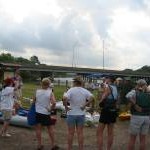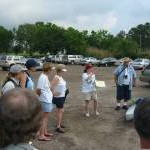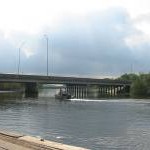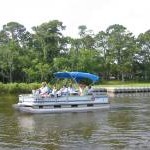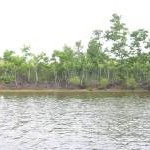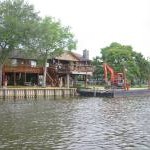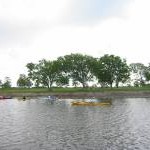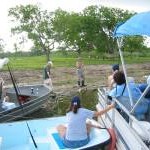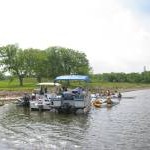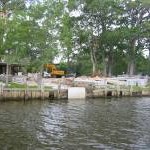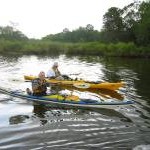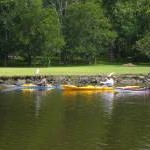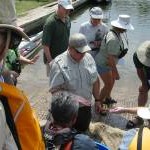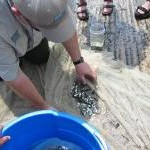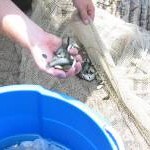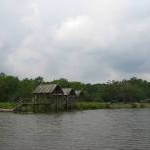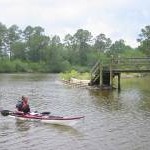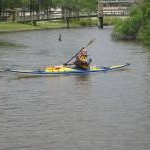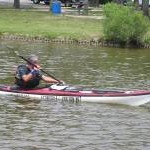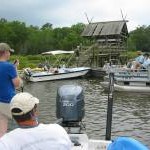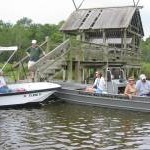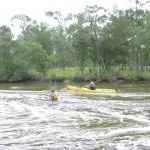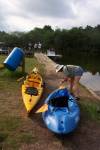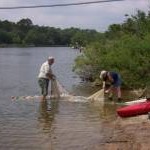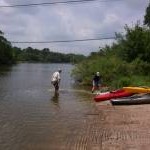May 22, 2006 Dickinson Bayou Tour
Thanks goes out to all those who atteneded and especially to those that volunteered the use of their watercrafts!
Steve Hillman – Hillman Shrimp and Oyster Co.
Jim Keese
Stan Duitscher
Galveston Bay Estuary Program
Jan Culbertson
Monday, May 22nd was a beautiful day to be out on the water, especially if that water happened to be Dickinson Bayou. The Dickinson Bayou Watershed Partnership organized a tour of Dickinson Bayou that day to illustrate the issues facing the bayou and its watershed.
The tour was well attended with representatives from the Cities of Dickinson and Friendswood, landowners along the bayou, Galveston Bay Area Master Naturalists, Keep Dickinson Beautiful, Galveston Bay Estuary Program, Galveston Bay Foundation, Texas Parks and Wildlife, Texas General Land Office, Galveston Bay Eco-Paddle Association, Hillman Shrimp & Oyster Co., and Texas Coastal Watershed Program.
The tour participants, some in boats or pontoon and others in their own kayaks, launched from the Highway 3 public boat ramp in Dickinson. First stop on the tour was a visit to the Asher property. The property is located approximately 1½ to 2 miles downstream (east) of the boat ramp at Highway 3, approximately ¼ mile downstream of the Dickinson Country Club. Along the way to the property it was noted that a significant amount of shoreline on bayou was bulkheaded, many in several states of disrepair. Bulkheading is the shoreline stabilization method that creates a vertical wall. Problems associated with bulkheading include not being aesthetically pleasing and not absorbing the wave energy generated by motorized traffic on the bayou. The wave action created by pontoons/boats/jet skis who do not obey no-wake zones bounces off the bulkheading and back into the bayou where it can increase erosion on unstablized shorelines. The property owned by the Asher’s was especially interesting since they have recently installed, in cooperation with the Galveston Bay Foundation and Texas General Land Office, an alternative form of shoreline stabilization. The property has incorporated a combination of riprap and wetland vegetation to stabilize the shore and provide an important wildlife habitat. The wetland plant species planted on the property include smooth cordgrass (Spartina alterniflora) and California bulrush (Scirpus californicus). Benefits associated with this type of stabilization structure is that it is more pleasing to the eye, the vegetation planted provides a habitat for birds and animals, and the riprap and well rooted wetland vegetation do a better job of absorbing and breaking up the wave action. Another key benefit of the alternative shoreline project relative to a bulkheading is the cost savings. The alternative shoreline stabilization project costs approximately $40 per linear foot (including the planted area behind the riprap), versus $100-150 (or more in some cases) per linear foot for a bulkhead. The installation of the project was awarded partial funding through a grant program administered by the Galveston Bay Foundation. On the tour Jim Dobberstine with the Foundation provided the tour attendees an overview of the project.
The next stop on the tour required heading back upstream to the Highway 3 boat ramp where Texas Parks and Wildlife representatives, Derek York and Leslie Williams were available to demonstrate some of the sampling equipment used in Dickinson Bay. The equipment included a bag seine, oyster dredge and a shrimp trawl. Derek and Leslie then used the bag seine to capture the following fish species at the boat ramp:
Common Name Scientific Name
Penfish or known also as Piggy Perch L. rhomboides
Gulf Killifish Fundulus similis
Sheepshead Minnow Cyprinodon variegatus
Spot L. xanthurus
Mosquito Fish Gambusia affinis
Stripped Mullet Mugil cephalus
Gobi (found in the oysters) G. bosc
Paul Hopkins Park was the final stop on the tour and is upstream of the Highway 3 Bridge. Along the way to the park several new housing developments under construction were observed, with once again the majority of the shoreline being bulkheaded. At Paul Hopkins Park, Charriss York with Texas Cooperative Extension/Texas Coastal Watershed Program described the upcoming wetland restoration planting that will take place in the park in the fall of 2006. The goal of the project is to create a wetland habitat by planting species that intentionally don’t taste quite as appealing to the wildlife (grass carp and Muscovy ducks in particular) around the park. These species have destroyed previous planting initiatives. Plants currently on the list to be installed include swamp lily (Crinum americanum) and southern blue Iris (Iris virginica). After these two species have a chance to get established other plant species may be added at a later time.
The goal of the tour was to raise understanding regarding some of the issues the bayou and watershed are facing which includes shoreline erosion and stabilization, increased development pressures, and loss of wetland and natural areas. The tour could only provide a snapshot of what is currently occurring, but it definitely served as a vehicle to increase the awareness of the attendees. The Dickinson Bayou Watershed Partnership believes that events such as the tour, which are important for outreach and education, work to promote the protection, preservation and restoration of the quality of the Dickinson Bayou Watershed and its communities.
- Tour participants getting ready to launch
- Tour participants ready to hit the water
- Susan Benner giving the participants a run down of the mornings activities
- Boats launching from the Hwy 3 boat ramp in Dickinson
- Bulkheading along the bayou
- Stan Duitscher’s pontoon
- Galveston Bay Estuary Program’s (GBEP) boat
- Jan Culbertson’s boat to the left and the GBEP’s boat to the right
- Vegetation along the bayou
- Failing bulkheading along the bayou
- Construction along the bayou
- Kayakers are very photogenic
- Kayakers in full force on the tour
- Jim Dobberstine with the Galveston Bay Foundation gives a presentation regarding the Asher’s Property which is using alternative methods for shoreline stabilization
- The newly planted shoreline at the Asher’s property
- Jim speaking to the group
- Boats and kaykers at the Asher’s property
- Kayakers demonstrating their skills
- Everyone is right side up again
- Concrete bulkheading being installed
- Broken concrete used for shoreline stabilization
- Skillful kayakers on the bayou
- Kayakers on the bayou looking great!
- Wastewater treatment facility on Dickinson Bayou
- Looking at the results of the sampling
- Derek shows the attendees the fish caught in the bag seine
- Derek and Leslie identifying the fish for everyone
- Fish caught in the bag seine
- Paul Hopkins Park – A Galveston County Park along the bayou
- More kayaker pictures
- Kayaking at Paul Hopkins Park
- Kayaking at Paul Hopkins Park
- Charriss York with Texas Cooperative Extenstion speaks about the wetland restoration project that will take place at Paul Hopkins Park in the Fall of 2006
- Tour attendees listening to Charriss about the goals of the wetland restoration project
- Kayakers getting some wave action from the boats
- Sara Snell getting her kayak ready for the trip
- Derek York and Leslie Williams with Texas Parks and Wildlife (TPWD) providing a demonstration on sampling with a bag seine at the Hwy 3 boat ramp
- Derek walking out into the bayou with the bag seine
- Derek and Leslie identifying the fish for everyone


